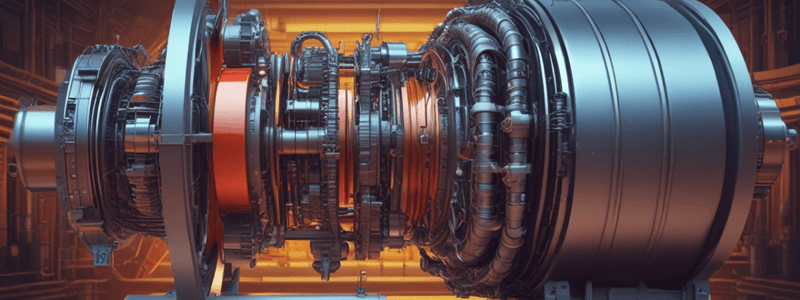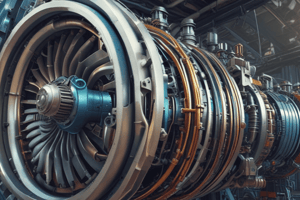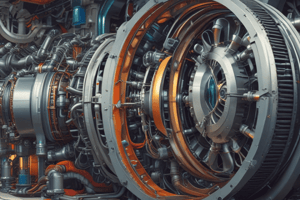Podcast
Questions and Answers
What is a key advantage of permanent magnetic generators (PMGs) in comparison to conventional generators?
What is a key advantage of permanent magnetic generators (PMGs) in comparison to conventional generators?
- They are not suitable for high-altitude operations.
- They need constant power supply to maintain field operation.
- They are larger in size.
- They require no brushes or slip rings. (correct)
How do brushless alternators differ from traditional alternators in terms of cooling?
How do brushless alternators differ from traditional alternators in terms of cooling?
- Brushless alternators do not require cooling.
- Traditional alternators are air cooled.
- Brushless alternators are water cooled.
- Brushless alternators are air cooled. (correct)
What is the main function of an exciter field in a brushless alternator?
What is the main function of an exciter field in a brushless alternator?
- To connect the generator to the power source.
- To induce current into the field coil. (correct)
- To generate output voltage directly.
- To cool down the alternator.
Why are brushless alternators more efficient at high altitudes compared to traditional alternators?
Why are brushless alternators more efficient at high altitudes compared to traditional alternators?
In a brushless alternator, what produces the magnetic flux to start the generator?
In a brushless alternator, what produces the magnetic flux to start the generator?
What is the purpose of the main output field in a brushless alternator?
What is the purpose of the main output field in a brushless alternator?
What determines the direction of current movement in an electrical circuit?
What determines the direction of current movement in an electrical circuit?
What do variations in the negative alternation of a sine wave indicate?
What do variations in the negative alternation of a sine wave indicate?
What does the amplitude of a sine wave represent?
What does the amplitude of a sine wave represent?
In which waveform is the alternating current (AC) most commonly identified?
In which waveform is the alternating current (AC) most commonly identified?
How are both current and voltage represented in a sine wave?
How are both current and voltage represented in a sine wave?
When is current considered to be flowing in a positive direction on a sine wave?
When is current considered to be flowing in a positive direction on a sine wave?
What is the phase difference between the voltages generated in the three windings of a three-phase alternator?
What is the phase difference between the voltages generated in the three windings of a three-phase alternator?
What is the relationship between the voltage at terminal C and the phase voltages A and B in a two-phase alternator?
What is the relationship between the voltage at terminal C and the phase voltages A and B in a two-phase alternator?
Why is the two-phase alternator seldom seen in actual use?
Why is the two-phase alternator seldom seen in actual use?
What is the purpose of the small vector diagram mentioned in the text?
What is the purpose of the small vector diagram mentioned in the text?
What is the main advantage of the three-phase alternator over the single-phase type?
What is the main advantage of the three-phase alternator over the single-phase type?
Why is the schematic diagram of a three-phase stator complex and difficult to understand?
Why is the schematic diagram of a three-phase stator complex and difficult to understand?
What is the primary function of the exciter field winding in a brushless alternator?
What is the primary function of the exciter field winding in a brushless alternator?
How is the output of the main generator regulated in a brushless alternator?
How is the output of the main generator regulated in a brushless alternator?
Which component(s) rotate as a unit in a brushless alternator?
Which component(s) rotate as a unit in a brushless alternator?
Where are the main output stator windings located in a brushless alternator?
Where are the main output stator windings located in a brushless alternator?
What is the purpose of the six silicon diodes in a brushless alternator?
What is the purpose of the six silicon diodes in a brushless alternator?
Why is there no need to 'flash the field' in a brushless alternator?
Why is there no need to 'flash the field' in a brushless alternator?
What is the primary advantage of using a permanent magnet in a generator?
What is the primary advantage of using a permanent magnet in a generator?
What does a sinusoidal sine wave represent in the context of a generator?
What does a sinusoidal sine wave represent in the context of a generator?
What distinguishes alternating current (AC) from direct current (DC)?
What distinguishes alternating current (AC) from direct current (DC)?
What is the most common waveform associated with alternating current (AC)?
What is the most common waveform associated with alternating current (AC)?
When does a conductor produce a greater potential difference (or induced EMF) in a generator?
When does a conductor produce a greater potential difference (or induced EMF) in a generator?
What does each cycle of a sine wave represent in the context of a generator?
What does each cycle of a sine wave represent in the context of a generator?
What is the main difference in speed calculation between a three-phase motor with six poles and a single-phase motor with two poles?
What is the main difference in speed calculation between a three-phase motor with six poles and a single-phase motor with two poles?
What is the primary characteristic of synchronous motors in terms of speed?
What is the primary characteristic of synchronous motors in terms of speed?
What is the percentage difference between the full-load speed and the synchronous speed in asynchronous motors called?
What is the percentage difference between the full-load speed and the synchronous speed in asynchronous motors called?
What are the two practical methods mentioned in the text to change the rotation speed of AC induction motors?
What are the two practical methods mentioned in the text to change the rotation speed of AC induction motors?
What type of device are induction motors considered to be?
What type of device are induction motors considered to be?
For applications requiring accurate speed control, what is recommended?
For applications requiring accurate speed control, what is recommended?
What is a disadvantage of a synchronous motor in terms of starting?
What is a disadvantage of a synchronous motor in terms of starting?
What is the purpose of adding a squirrel-cage winding to the rotor of a synchronous motor?
What is the purpose of adding a squirrel-cage winding to the rotor of a synchronous motor?
What does the heavy copper bars shorted together by copper rings in a squirrel cage winding resemble?
What does the heavy copper bars shorted together by copper rings in a squirrel cage winding resemble?
Why does a relatively large current flow in the squirrel cage of a synchronous motor?
Why does a relatively large current flow in the squirrel cage of a synchronous motor?
What occurs to the rotor in a synchronous motor when AC is applied to the stator?
What occurs to the rotor in a synchronous motor when AC is applied to the stator?
What is the main function of a squirrel-cage winding in a synchronous motor?
What is the main function of a squirrel-cage winding in a synchronous motor?
What is the main reason an induction motor cannot run at synchronous speed?
What is the main reason an induction motor cannot run at synchronous speed?
What is the name given to the difference between the speed of the rotating stator field and the rotor speed in an induction motor?
What is the name given to the difference between the speed of the rotating stator field and the rotor speed in an induction motor?
What is the purpose of the small air gap between the rotor and stator in an induction motor?
What is the purpose of the small air gap between the rotor and stator in an induction motor?
What is the main force that causes the rotor of an induction motor to move in the same direction as the rotating stator field?
What is the main force that causes the rotor of an induction motor to move in the same direction as the rotating stator field?
How does increasing the resistance in an induction motor affect its speed?
How does increasing the resistance in an induction motor affect its speed?
What is the purpose of using a star-delta arrangement for starting large 3-phase induction motors?
What is the purpose of using a star-delta arrangement for starting large 3-phase induction motors?
What is the relationship between the torque angle and the load on a synchronous motor?
What is the relationship between the torque angle and the load on a synchronous motor?
What is the maximum value of torque that a synchronous motor can develop without losing synchronism?
What is the maximum value of torque that a synchronous motor can develop without losing synchronism?
What happens to a synchronous motor if the mechanical load is increased beyond the pull-out torque?
What happens to a synchronous motor if the mechanical load is increased beyond the pull-out torque?
In a star-wound stator winding, what is the effective voltage across each winding compared to a delta-wound winding?
In a star-wound stator winding, what is the effective voltage across each winding compared to a delta-wound winding?
What is the purpose of using a star-delta arrangement for starting large 3-phase induction motors?
What is the purpose of using a star-delta arrangement for starting large 3-phase induction motors?
What is the primary reason for split-phase motors being limited to small sizes?
What is the primary reason for split-phase motors being limited to small sizes?
What is the primary advantage of permanent-split capacitor motors?
What is the primary advantage of permanent-split capacitor motors?
How does a resistance-start motor differ from a capacitor-start motor?
How does a resistance-start motor differ from a capacitor-start motor?
What is a common application for permanent-split capacitor motors?
What is a common application for permanent-split capacitor motors?
Why are split-phase motors used in applications where high starting torque is not required?
Why are split-phase motors used in applications where high starting torque is not required?
How can you identify a capacitor start motor?
How can you identify a capacitor start motor?
Study Notes
Permanent Magnetic Generators (PMGs)
- PMGs offer higher efficiency and reduced maintenance compared to conventional generators due to the absence of excitation losses.
Brushless Alternators
- Brushless alternators cool differently; they use airflow over their components instead of brushes which require maintenance and wear over time.
- The exciter field in a brushless alternator generates the magnetic field necessary for operation.
- Brushless alternators perform more efficiently at high altitudes due to minimized losses from air density changes affecting their cooling systems.
Electromagnetic Principles
- In a brushless alternator, magnetism is initially produced by a rotating permanent magnet or by the exciter.
- The main output field in a brushless alternator converts electrical energy to mechanical energy, maintaining the operational frequency.
Electrical Circuit Dynamics
- Current direction in a circuit is determined by the voltage polarity applied to the circuit elements.
- Negative alternation variations in a sine wave indicate changes in electrical activity and signal transmission.
- The amplitude of a sine wave represents the peak voltage or current, determining the power capacity of the circuit.
Alternator Waveforms
- Alternating current (AC) is most commonly identified by the sine wave.
- Sine waves visually depict both current and voltage fluctuations over time.
- Current is considered positive during the upward slope of the sine wave.
Three-Phase and Two-Phase Alternators
- In a three-phase alternator, the voltages generated in the windings are phase-shifted by 120 degrees.
- In a two-phase alternator, terminal C voltage results from the vector sum of phase voltages A and B, but it is rarely used in practice due to complexity and inefficiency.
- A small vector diagram helps visualize phasing and voltage relationships within the alternator.
Advantages of Alternator Designs
- The three-phase alternator surpasses single-phase ones in efficiency and power output, allowing for smoother operation.
- The complexity of the schematic diagram in a three-phase stator makes it challenging to understand due to multiple windings and phase interactions.
Exciters and Regulation
- The exciter field winding's primary function is to supply the necessary voltage to the main alternator.
- Output regulation in a brushless alternator occurs through active monitoring and adjustments by the control systems.
Component Functions in Brushless Alternators
- In brushless alternators, the rotor and exciter typically rotate as a unit.
- Main output stator windings are stationary and generate electrical output.
- The six silicon diodes serve to convert AC to DC, allowing usage for various applications.
- No need to 'flash the field' exists as the permanent magnets maintain the existing magnetic field.
Generator and Current Characteristics
- A permanent magnet enhances generator performance by eliminating the need for an external power supply for excitation.
- A sinusoidal wave relates to alternating current generators and depicts its cyclical nature.
- AC is characterized by its bidirectionality, contrasting with the unidirectional flow of DC.
Induction Motor Dynamics
- A conductor produces greater potential difference when moving within a magnetic field.
- Each sine wave cycle represents a single period of voltage and current fluctuation in a generator.
- A three-phase motor with six poles has a different speed calculation compared to a two-pole single-phase motor, affecting overall performance.
- Synchronous motors maintain constant speed as they operate at synchronous speed, with slight variations divided by the full-load speed and synchronous speed termed slip.
Motor Control and Characteristics
- AC induction motors are considered rotating electrical devices.
- For precise speed control, variable frequency drives (VFDs) are recommended.
- Synchronous motors face challenges in starting due to their strict operational requirements.
- Squirrel-cage windings provide torque in synchronous motors by inducing currents via the stator's rotating magnetic field.
- High current in the squirrel cage results from induced EMF when the stator is energized.
Induction Motor Operation
- The rotor experiences movement through the interaction with the moving magnetic field generated by AC supply.
- The air gap between the rotor and stator allows for effective magnetic coupling and torque generation.
Torque and Load Relationships
- The torque angle in synchronous motors is directly related to the mechanical load; higher loads increase the angle.
- Maximum torque without losing synchronism is known as the pull-out torque, exceeding this leads to loss of synchronization under heavy loads.
Winding Configurations
- In star-wound stator configurations, voltage across each winding is less than in delta-wound configurations, thus influencing application in specific systems.
- Star-delta arrangements are used to manage starting currents and gradually increase voltage in large three-phase induction motors.
Split-Phase and Capacitor Motors
- Split-phase motors are limited to small sizes due to design inefficiencies.
- Permanent-split capacitor motors have advantages in maintaining efficiency and simplicity.
- Resistance-start motors differ by using resistors to help initiate rotation, compared to capacitor-start motors that utilize capacitors for starting torque.
- Permanent-split capacitor motors are common in single-phase applications.
- Split-phase motors are suitable for low-torque applications while capacitor-start motors are identifiable by their additional starting capacitor.
Studying That Suits You
Use AI to generate personalized quizzes and flashcards to suit your learning preferences.
Description
Learn about permanent magnetic generators (PMGs) which do not require power to be supplied to the field, eliminating the need for brushes or slip rings. Discover how PMGs can be designed to operate in either voltage mode or current mode, and their importance in providing power to various components on gas turbine engines.




